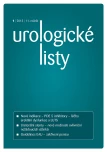Gender as a factor influencing clinico-pathological parameters and prognosis of renal cell carcinoma
Authors:
V. Bartoš; R. Mráz; J. Mikuláš
Published in:
Urol List 2013; 11(1): 60-63
Overview
Background:
Renal cell carcinoma (RCC) represents a heterogeneous group of oncological entities, that are characterized by some gender-related differences.
Aim:
The purpose of our paper was to evaluate the basic clinico-pathological parameters of the patients with RCC and to assess their gender-related disparities.
Material and methods:
A study group consisted of 172 bioptically verified cancers from 170 subjects (106 men, 64 women) in the age range between 18–90 years.
Results:
The mean age of the patients was almost the same for both sexes (men 63.0 years, women 62.3 years). A right kidney was more frequently affected in men (60.2%) and a left kidney in women (59.3%). Histologically, in both subgroups, clear cell type of RCC prevailed with approximately the same percentage (85.2 vs 84.4%). Papillary RCC occurred more commonly in men (12 vs 4.6%) and conversely, chromophobe RCC in women (6.2 vs 1.9%). Pathological stages confined to the kidney (pT1 and pT2) represented 64.8% and 76.6% in men and women, respectively. Stages with extrarenal propagation (pT3 and pT4) were found to be more common in men (35.2%) than women (23.4%). Compared to women, male gender exhibited larger cancers (mean size 4.9 vs 4.1 cm), more common multifocal lesions (13.9 vs 7.8%), more frequent metastatic involvement of the regional lymph nodes (9,2 vs 4,6%), as well as necrotic (43.5 vs 25%) and sarcomatoid changes (10.2 vs 7.8%) and their tumors tended to be poorely differentiated.
Conclusion:
Our study showed, that depending on gender, there were some differences in several clinico-pathological parameters of disease. Males more frequently exhibited unfavourable histomorphological findings, that probably correspond with their worse prognosis reported in the literature.
Key words:
renal cell carcinoma, gender, prognosis
Sources
1. Galbavý Š. Patológia nádorov obličiek. Onkológia 2010; 5(5): 251–253.
2. Tešľa Ľ, Nagy V, Valanský L. Prognostické faktory a modely u pacientov s karcinómom obličky – súčasný prehľad. Klin Urol 2010; 6(3): 124–130.
3. Chen J, Shi B, Zhang D et al. The clinical characteristics of renal cell carcinoma in female patients. Int J Urol 2009; 16(6): 554–557.
4. Eble JN (eds). World Health Organization of tumours. Pathology & Genetics. Tumours of the urinary system and male genital organs. Lyon: IARCPress 2004 : 12–40.
5. Vít V. Nádorové markery u renálního karcinomu: pomoc při diagnostice, prognóze, léčbě a sledování. Urol List 2010; 8(2): 11–15.
6. Aron M, Nguyen MM, Stein RJ et al. Impact of gender in renal cell carcinoma: an analysis of the SEER database. Eur Urol 2008; 54(1): 133–140.
7. Beisland C, Medby PC, Beisland HO. Renal cell carcinoma: gender difference in incidental detection and cancer-specific survival. Scand J Urol Nephrol 2002; 36(6): 414–418.
8. Woldrich JM, Mallin K, Ritchey J et al. Sex differences in renal cell cancer presentation and survival: an analysis of the National Cancer Database, 1993–2004. J Urol 2008; 179(5): 1709–1713.
9. Onishi T, Oishi Y, Goto H et al. Gender as a prognostic factor in patients with renal cell carcinoma. BJU Int 2002; 90(1): 32–36.
10. Lee S, Jeon HG, Kwak C et al. Gender-specific clinicopathological features and survival in patients with renal cell carcinoma (RCC). BJU Int 2012; 110 (2 Pt 2): E28–E33.
11. Schrader AJ, Sevinc S, Olbert PJ et al. Gender-specific characteristics and survival of renal cell carcinoma. Urologe A 2008; 47(9): 1184–1186.
12. Fuhrman SA, Lasky LC, Limas C. Prognostic significance of morphologic parameters in renal cell carcinoma. Am J Surg Pathol 1982; 6(7): 655–663.
13. Kawaciuk I, Hyršl L, Dušek P et al. Vliv věku, pohlaví a ECOG skóre na prognózu karcinomu ledvin. Čes Urol 2005; 9(3): 31–35.
14. Nardi AC, Zequi Sde C, Clark OA et al. Epidemiologic characteristics of renal cell carcinoma in Brazil. Int Braz J Urol 2010; 36(2): 151–158.
15. Waalkes S, Rott H, Herrmann TR et al. Does male sex influence the prognosis of patients with renal cancer? Onkologie 2011; 34(1–2): 24–28.
16. Taccoen X, Valeri A, Descotes JL et al. Renal cell carcinoma in adults 40 years old or less: young age is an independent prognostic factor for cancer-specific survival. Eur Urol 2007; 51(4): 980–987.
17. Kabat GC, Silvera SA, Miller AB et al. A cohort study of reproductive and hormonal factors and renal cell cancer risk in women. Br J Cancer 2007; 96(5): 845–849.
18. Lambe M, Lindblad P, Wuu J et al. Pregnancy and risk of renal cell cancer: a population-based study in Sweden. Br J Cancer 2002; 86(9): 1425–1429.
19. Cheville JC, Lohse C, Zincke H et al. Comparisons of outcome and prognostic features among histologic subtypes of renal cell carcinoma. Am J Surg Pathol 2003; 27(5): 612–624.
20. Belej K, Fiala R, Jezdinská V et al. Karcinom ledviny ze zběrných kanálků – kazuistika. Čes Urol 2003; 7(2): 40–42.
21. De Peralta-Venturina M, Moch H, Amin M et al. Sarcomatoid differentiation in renal cell carcinoma: a study of 101 cases. Am J Surg Pathol 2001; 25(3): 275–284.
22. Brannon AR, Haake SM, Hacker KE et al. Meta-analysis of clear cell renal cell carcinoma gene expression defines a variant subgroup and identifies gender influences on tumor biology. Eur Urol 2012; 61(2): 258–268.
23. Langner C, Ratschek M, Rehak P et al. Steroid hormone receptor expression in renal cell carcinoma: an immunohistochemical analysis of 182 tumors. J Urol 2004; 171 (2 Pt 1): 611–614.
24. Tanaka Y, Sasaki M, Kaneuchi M et al. Estrogen receptor alpha polymorphisms and renal cell carcinoma – a possible risk. Mol Cell Endocerinol 2003; 202(1–2): 109–116.
Labels
Paediatric urologist UrologyArticle was published in
Urological Journal

2013 Issue 1
Most read in this issue
- Varicocele and the signification of its repair
- EAU Guidelines on penile curvature
- A review of current practices and controversies in the use of indwelling ureteric stents
- Tadalafil in the treatment of LUTS/BPH and ED
